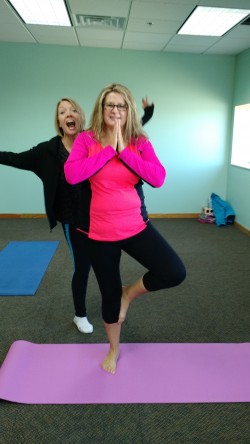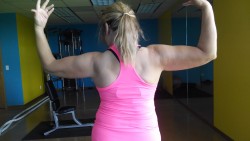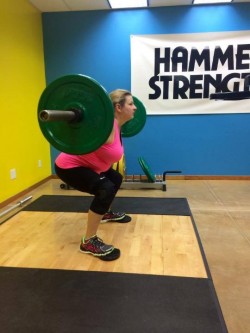A fibromyalgia diagnosis doesn’t have to mean the end of everything fun. Here’s the rest of the story of how I got back to feeling like a Rock Star (or, if you remember the 80’s, better than a Rock Star most likely.HA)
2. Exercise.
Your body was made to move, not made to sit on your ass all day every day. But, modern living being what it is, we all have to make a living. That is what makes exercise doubly important.
I know it’s hard to start new habits, but it’s an absolute necessity if you want to feel better.
Exercise is also one of those things that’s a process. You need to do it consistently. Find something that you enjoy doing that helps you move.
Be patient! We live in such an instant gratification society that when people don’t get fit or feel better instantly, they give up.
If you’re starting an exercise program for the first time, start out slow. Walk 5 or 10 minutes every day for a couple of weeks to give yourself time to adjust. Each week after that, add a couple of minutes or a couple of blocks.
For instance, let’s say you’ve decided to take the plunge and start exercising. The absolute worst thing you can do is overdo and end up really sore, which makes you dread your workouts. You’re simply dooming yourself to fail if that’s the road you take.
For example, what if you started walking 5 minutes every day for a week. That’s it. Just 5 minutes a day. The next week, add two minutes per day, and the next week, another two minutes. That’s 120 seconds of additional walking per day each week. Then continue adding two more minutes per per day each week after that.
At the end of 3 months, you’d be walking almost 30 minutes per day. If you walked 6 days per week, that’s THREE hours of exercise a week! Phenomenal! See how it adds up, folks? Where else would you be in 3 months?
Just think: you went from ZERO to THREE hours a week in only THREE months. That doesn’t sound too shabby, does it? And you only started with 5 minutes per day.
I’m a Slow and Steady Wins the Race kind of gal myself, that’s why I think this way.
Progress is still progress, however long it takes. Do you think it matters now that it took me 12 years to finish my college degree? Heck no! And as far as I was concerned, it didn’t even matter then! 😀
Once you’re up to speed with a walking program, gradually add in some weight bearing exercise. Weight-bearing exercise is so important to prevent osteoporosis as well as help keep your strength up as you age. Weight-bearing exercise will help you balance out your body strength so you don’t fall, help slow or prevent your muscles from shrinking which naturally occurs as you age, and help you get up off the toilet. 😉
I highly recommend consulting with a trainer or utilizing machines to make sure you are doing the exercise correctly in order to prevent injury. Again, work up slowly.
When I started lifting weights is when I really started to see improvement.
And remember: not all muscle soreness is bad!
If you’re starting an exercise program, you may feel some soreness. A little soreness is natural; you just want to avoid the intense muscle soreness that hurts so much it discourages you. Shoot, if you’ve ever had a massage, you know your muscles are sometimes sore afterwards.
This does not mean it’s bad, or that your fibromyalgia is acting up. There IS a difference.
3. Consider Supplementation.
 You’re right, this picture has absolutely nothing to do with this post. I was just checking to see if you were paying attention. 😉
You’re right, this picture has absolutely nothing to do with this post. I was just checking to see if you were paying attention. 😉
Do you take a probiotic regularly? If you don’t, you should. A probiotic is an over-the-counter supplement which contains good bacteria to keep your gut healthy. Gut health, or lack thereof, is a factor behind many illnesses. While you may not notice an immediate improvement upon taking it, over the long term it makes a huge difference.
If you don’t like or eat seafood, check out a good quality fish oil supplement.
Talk to your doctor about other supplements. Besides a probiotic, I take Vitamin C, Vitamin D (unless I’m out in the sun), and Magnesium. I also am an avid user of essential oils, which promote and support good health, energy and a healthy immune system without adding chemicals to my life.
4. Get Plenty of Sleep.
Wind down naturally at the end of the day, allowing yourself some time to relax, at least an hour before bed.
Stay off electronic devices. Make sure your room is dark; get some blackout drapes if you have to. Keep a small flashlight by the bed for bathroom breaks.
Watch your alcohol intake; it can be especially disruptive to sleep. (I know this from experience.)
Try bathing at night instead of a shower if you have a tub to help you relax. Rub your pillow with lavender (a good quality essential oil) to help you sleep. I diffuse lavender at night, which helps us relax and sleep better.
Try some gentle stretches to release muscle tension and prepare your body physically for sleep.
Consider the use of white noise to help you sleep better and block out other noises. My husband and I use a fan. The TV does NOT count as white noise, sorry. 😀
5. Take Care of Yourself.
Keeping your stress level low is incredibly important. Learn to say no, stop trying to do everything, recognize your limitations, and give yourself a break.
I have taken up yoga this year, and I really love what it does for me, mentally and physically.
 Not to mention the people in the class, of course. 😀
Not to mention the people in the class, of course. 😀
I hope you found this helpful, and wish you the best of luck in your journey to good health. Unfortunately, there are no shortcuts! But day to day, it will make a difference. 🙂
Cheers!




